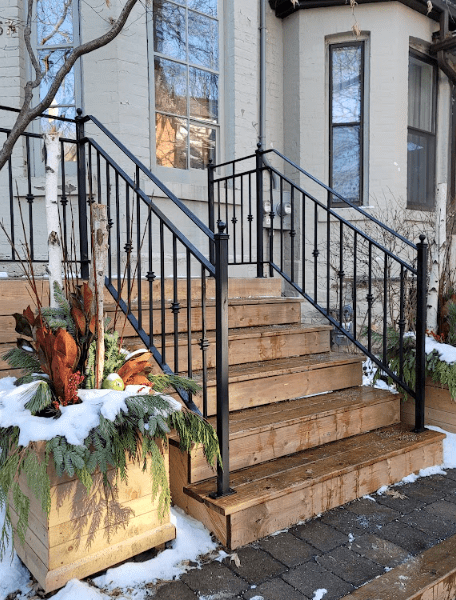Last Updated on June 16, 2025 by chanuka chanuka.23e2
Published: March 03, 2025
Steel railings are a popular choice for both residential and commercial properties due to their durability and sleek appearance. However, winter conditions can pose a significant threat, as snow, ice, and moisture increase the risk of rust and corrosion. Taking proactive steps to protect your steel railings during the winter months will not only maintain their aesthetic appeal but also extend their lifespan.

Key Takeaways
- Railings can be installed during winter with the right materials and preparation.
- Certain conditions, like frozen ground, may require specialized tools and techniques.
- Professional installation ensures safety and adherence to weather-specific guidelines.
Advantages of Installing Railings in Winter
- Faster Scheduling
- Contractors often have lighter workloads in winter, meaning quicker project timelines.
- You can avoid the rush of spring and summer home improvement seasons.
- Immediate Safety Benefits
- Installing railings during winter ensures safety on icy steps, decks, or walkways.
- Enhanced security can reduce the risk of slips and falls.
- Preparation for Warmer Months
Completing the installation now ensures your outdoor space is ready for spring and summer activities.
Challenges of Winter Railing Installation
Frozen Ground
- For ground-mounted railings, frozen soil can make digging and securing posts more challenging.
- Specialized equipment, like ground heaters or drills, may be required.
Cold Temperatures
- Adhesives, paints, or coatings might not cure properly in low temperatures.
- Contractors may need to use weather-specific materials designed for cold-weather application.
Weather Delays
- Snow, ice, or freezing rain can occasionally delay progress, especially on exposed surfaces.

Tips for a Successful Winter Railing Installation
- Choose the Right Materials
- Opt for weather-resistant materials such as aluminum, stainless steel, or vinyl.
- Avoid untreated wood, which can absorb moisture and warp in cold conditions.
- Work with Experienced Professionals
- Hire contractors familiar with winter installations to handle the unique challenges.
- Ensure they use proper tools and techniques for cold-weather conditions.
- Plan Around the Weather
- Schedule installation during clear weather to minimize disruptions.
- Monitor forecasts and be flexible with timelines if necessary.
- Prepare the Site
- Clear snow and ice from the installation area to ensure safety and efficiency.
- Mark utilities and other obstacles in advance to avoid complications.
- Use Cold-Weather Adhesives and Sealants
- Ensure that all adhesives, paints, or sealants are rated for low-temperature use to maintain durability.
Final Thoughts
Installing railings during winter is not only feasible but also beneficial in many cases. By choosing the right materials, working with experienced professionals, and preparing for seasonal challenges, you can ensure a successful and timely installation. Don’t let the colder months hold you back from improving the safety and style of your property.
FAQs
Is it more expensive to install railings in winter?
Last Updated on June 16, 2025 by chanuka chanuka.23e2
Not necessarily. In fact, some contractors may offer discounts during the off-season.
Can all types of railings be installed during winter?
Last Updated on June 16, 2025 by chanuka chanuka.23e2
Most types, including aluminum, steel, and vinyl, can be installed in winter. However, untreated wood may not perform well in cold conditions.
How long does winter installation take?
Last Updated on June 16, 2025 by chanuka chanuka.23e2
It depends on the project size and weather conditions, but most installations can be completed within a few days.
What precautions should be taken for winter installation?
Last Updated on June 16, 2025 by chanuka chanuka.23e2
Ensure the site is clear of snow and ice, use weather-rated materials, and work with experienced professionals.
Will the cold weather affect the durability of my railings?
Last Updated on June 16, 2025 by chanuka chanuka.23e2
No, as long as you use high-quality, weather-resistant materials and proper installation techniques.
 Chat
Chat 








